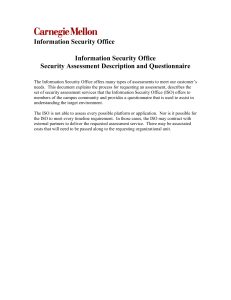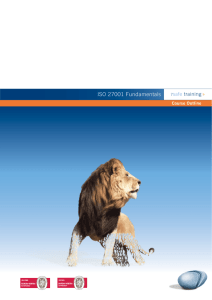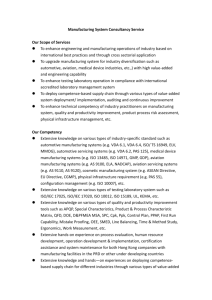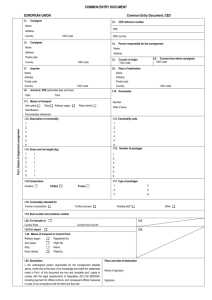Security Assessment Questionnaire
advertisement
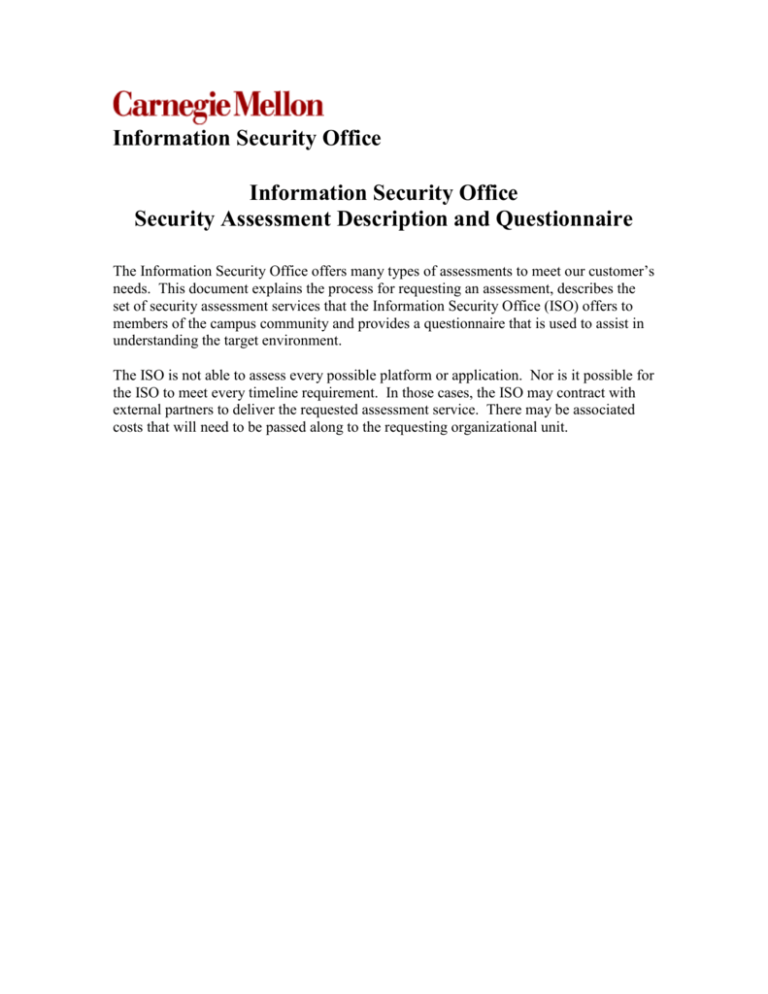
Information Security Office Information Security Office Security Assessment Description and Questionnaire The Information Security Office offers many types of assessments to meet our customer’s needs. This document explains the process for requesting an assessment, describes the set of security assessment services that the Information Security Office (ISO) offers to members of the campus community and provides a questionnaire that is used to assist in understanding the target environment. The ISO is not able to assess every possible platform or application. Nor is it possible for the ISO to meet every timeline requirement. In those cases, the ISO may contract with external partners to deliver the requested assessment service. There may be associated costs that will need to be passed along to the requesting organizational unit. Process: The Information Security Office has created a simple process around vulnerability assessments to provide clarity and consistency. The process is outlined and diagrammed below. 1. 2. 3. 4. Contact the ISO (request assessment) The ISO accepts the project A questionnaire (later in this document) is completed by the customer A scoping/kick-off meeting is held The goal of the meeting is to try to determine which type of assessment is appropriate, the scope of the assessment, a timeline and contact information. The product of the meeting is a Statement of Work that will be agreed upon and signed by both parties. 5. The assessment is scheduled (projected end date is noted as well) 6. Assessment is performed during agreed upon times The ISO and the customer will be in contact throughout the process. Any findings that are deemed urgent (presenting an immediate security risk) would be communicated immediately to the customer. 7. The assessment report is produced and reviewed by the ISO group 8. The report is distributed to the customer and a review meeting is scheduled 9. The wrap-up meeting is held where detailed findings are explained 10. Both groups sign off on the results Sponsor Initiated Security Assessment Track Time ISO ISO Produce Report Accepts Project No Distribute Questionaire, Schedule/Conduct Scoping Meeting Create SOW Create Password Protected PDF Conduct Assessment DISO Sign-off Secure PDF Distribution Sponsor/TargetEntity Entity Sponsor/Target Optional Findings Meeting Contact DISO Complete Questionare SOW Sign-Off Submit Final Time Expense to DISO Provide Assessment Support as Needed Sign-Off on Report Assessment Complete Security Assessment Services In this section, you will find the description of the most common assessment scenarios. These can be customized in many ways to meet a customer’s needs. Each type of assessment takes varying amounts of time and is impacted by the number of targets (applications, servers, networks, etc.). The exact type of assessment should be determined in the “kickoff” meeting. Network Based (Attack & Penetration) Penetration testing includes components of application vulnerability assessment, host vulnerability assessment, and security best practices. This type of test can be performed with or without detailed prior knowledge of the environment. When it is performed without prior knowledge additional steps will be taken to enumerate hosts and applications and to assess the ease with which any outsider could exploit publicly available information or social engineering to gain unauthorized access. An attack and penetration test will answer questions like: How vulnerable is the network, host, and application(s) to attacks from the internet or intranet? Can an intruder obtain unauthorized access to critical resources? Are social engineering techniques effective? Are operational controls effective? This would involve the ISO acting as an attacker and looking at the system as an outsider. The ISO would look for: Remotely exploitable vulnerabilities Patch levels (OS and Apps) Unnecessary services Weakness of encryption Weakness of authentication Etc. Host Based This is an assessment of the health and security of given workstation or server. Automated scanning tools (e.g. Nessus) are the primary vehicle for this type of assessment. Additional hands-on inspection may also be necessary to assess conformance to security best practice. This assessment will answer questions like: Is patching up to date? Are unnecessary services running? Are anti-virus/anti-malware signatures up to date? This would involve the ISO acting as a Sys Admin and auditing the system and applications looking for: Locally exploitable vulnerabilities Patch levels (OS and Apps) Access rights Security best practices Etc. Application This is an assessment of the functionality and resilience of the compiled application to known threats. This assessment focuses on the compiled and installed elements of the entire system: how the application components are deployed, communicate or otherwise interact with both the user and server environments. Application scanning tools as well as manual testing with and without application credentials are used to perform this assessment. Typically some host, network, and general information security practices are assessed as part an application vulnerability assessment. This assessment will answer questions like: Does the application expose the underlying servers and software to attack Can a malicious user access, modify, or destroy data or services within the system This would involve the ISO auditing an application (typically web based) and looking for vulnerabilities like: SQL Injection Cross Site Scripting Cross Site Request Forgery Improper data sanitization Buffer overflows (limited) Mis-configured/weak authentication Etc. Compliance This would involve the Information Security Office auditing (or assisting in the coordination of an audit if the ISO is not trained to conduct the specific audit) systems for compliance with specific regulations: HIPAA FERPA GLBA PCI Physical Security Assessment This assessment typically involves interviews with key staff, documentation review, and an on-site visit to assess appropriate physical and environmental controls for safeguarding computing resources. This assessment will answer questions like: Are there appropriate physical access controls in place for securing servers and desktop machines Are appropriate environmental controls in place to sustain critical computing infrastructure Are systems left logged in while staff are away Enterprise Security Assessment This is a comprehensive study of the hosts, networks, applications, environmental controls, as well as policies and procedures. This service is currently outsourced though ISO can serve as the engagement manager with a number of preferred suppliers. Questionnaire: The following questionnaire is necessary to guarantee the accuracy of the time estimates as well as the thoroughness of the assessment. Please fill out as much of the information as possible. Basic Information Name: Title: Telephone: Cell phone: Email address: All machines: IP Addresses OS All machine names (DNS, WINS, Virtual Hosts, etc.) Is your organization subject to any specific regulatory requirements? (Examples – SarbanesOxley, GLBA, HIPAA) Audit Information Would you like the Information Security Office to perform a network-based assessment? (A&P) How many Internet-facing hosts do you want the Information Security Office to assess? Would you like the Information Security Office to perform a host-based assessment? Which hosts? Would you like the Information Security Office to perform compliance, physical or enterprise assessment? If compliance, which regulations? (HIPAA, FERPA, etc.) Would you like the Information Security Office to perform an application security assessment? Which specific applications? (URL, Application name, Installer, etc.) Would you like this tested with or without credentials? Would you like this tested with or without administrative credentials? Network Security Information Has your organization ever been compromised (internally or externally)? List all IP address blocks registered to your organization. (Example – 12.34.56.x/24) List all the domain names registered to your organization. (Examples – acme.com; acmesales.com) Does your organization use a local Firewall(s)? If so, please list quantity and manufacturer(s) of firewall(s). Does your organization use a local Intrusion Detection System(s) (IDS)? Does your organization use a local Intrusion Prevention System(s) (IPS)? If your organization uses local IDS, do you use “host-based” IDS (HIDS) or “network-based” IDS (NIDS) or a combination of both? List the quantity of IDS (both HIDS and NIDS) and IPS devices, as well as the manufacturer(s). Do you use DMZ networks? Does your organization have any dedicated connections to other organization’s networks (vendors, business partners)? If so, please list all dedicated connections to other networks. Does your organization use any Remote Access services? Specifically, what type of remote access services does your organization use (VPN or Dial-Up RAS)? How many employees use remote access services? Does your organization use site-to-site Virtual Private Network (VPN) tunnels? If so, how many site-to-site VPN tunnels are in use? Does your organization have any systems that use modems? System Information How many Microsoft Windows NT/2000/2003 servers does your organization use? How many Unix servers (AIX, HPUX, Linux, Solaris, etc.) does your organization use? Please list specific distributions. List any servers with operating systems other than what is listed above. Please include quantities and list specific operating system versions/distributions. How many Microsoft Windows 2000/XP Professional clients does your organization use? List any clients with operating systems other than what is listed above. Please include quantities and list specific operating system versions/distributions. What Enterprise Resource Planning (ERP) application(s) does your organization use? (Examples – SAP, Peoplesoft, Oracle, JD Edwards) Please include a brief description of each. What E-commerce application(s) does your organization use? Please include a brief description of each. What database technologies does your organization use? (Examples – Oracle, Microsoft SQL, IBM DB2, MySQL) Please include a brief description of the purpose for each. Service Information What services do you expose to the internet? (Examples: Web, Database, FTP, SSH, etc.) What services do you expose to the campus? What type of authentication do you use for your web services? (Examples: PubCookie, Windows Integrated, htaccess, etc.) What languages do you use for your web services? (Examples: PHP, Perl, Ruby, ASP, etc.) What antivirus application(s) do you use? Is your antivirus application implemented using a “managed” client/server architecture, or in a stand-alone configuration?
